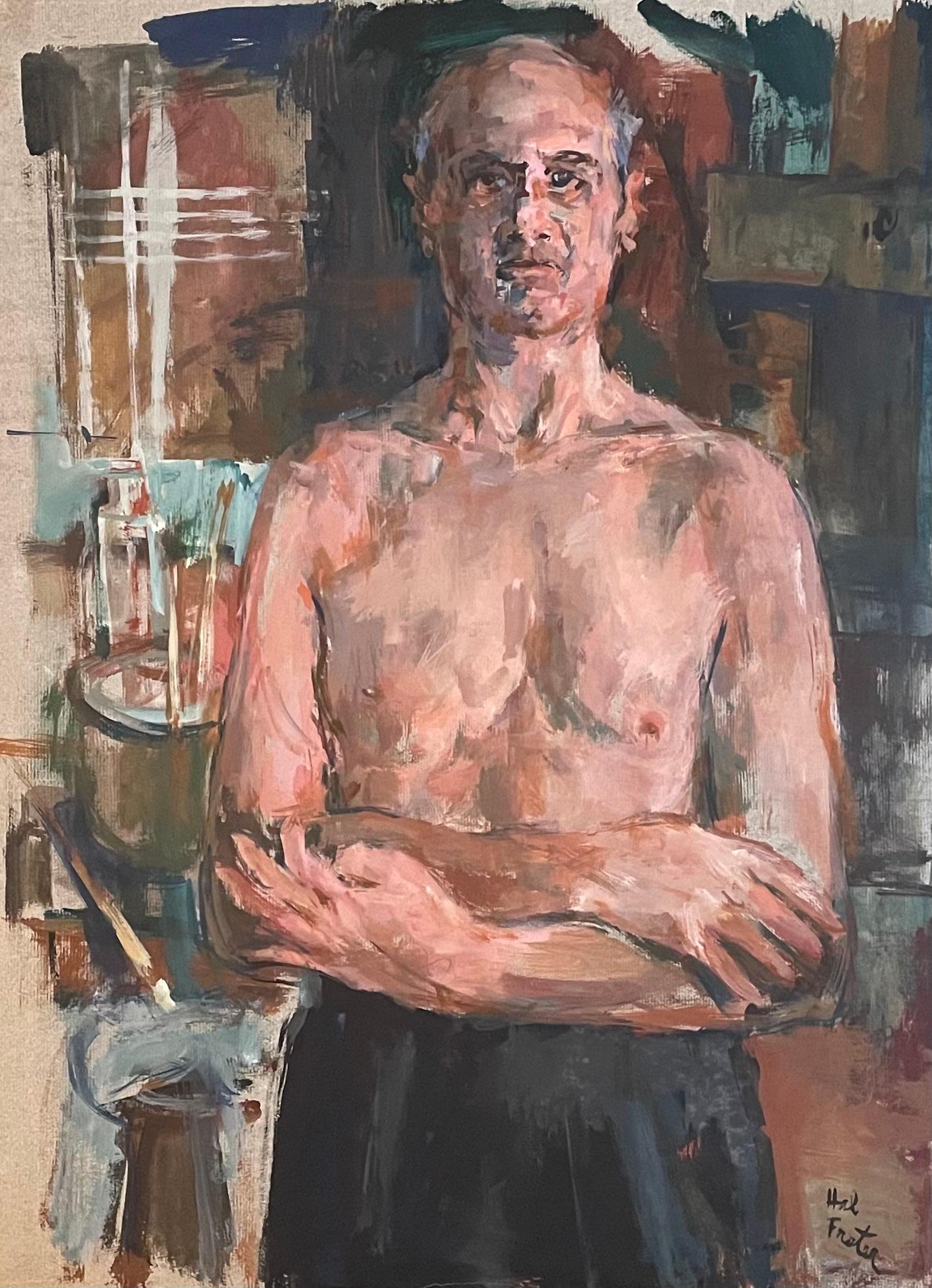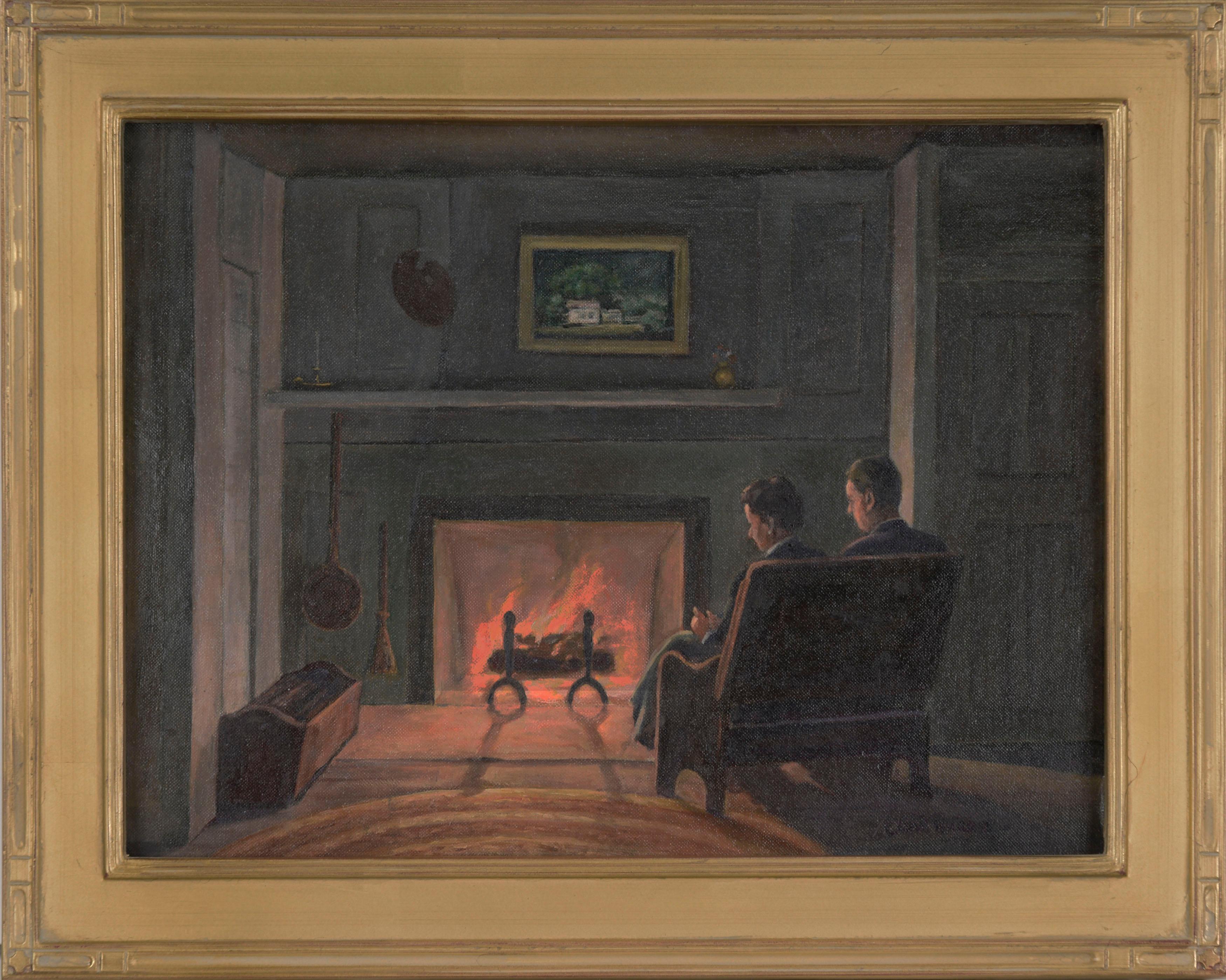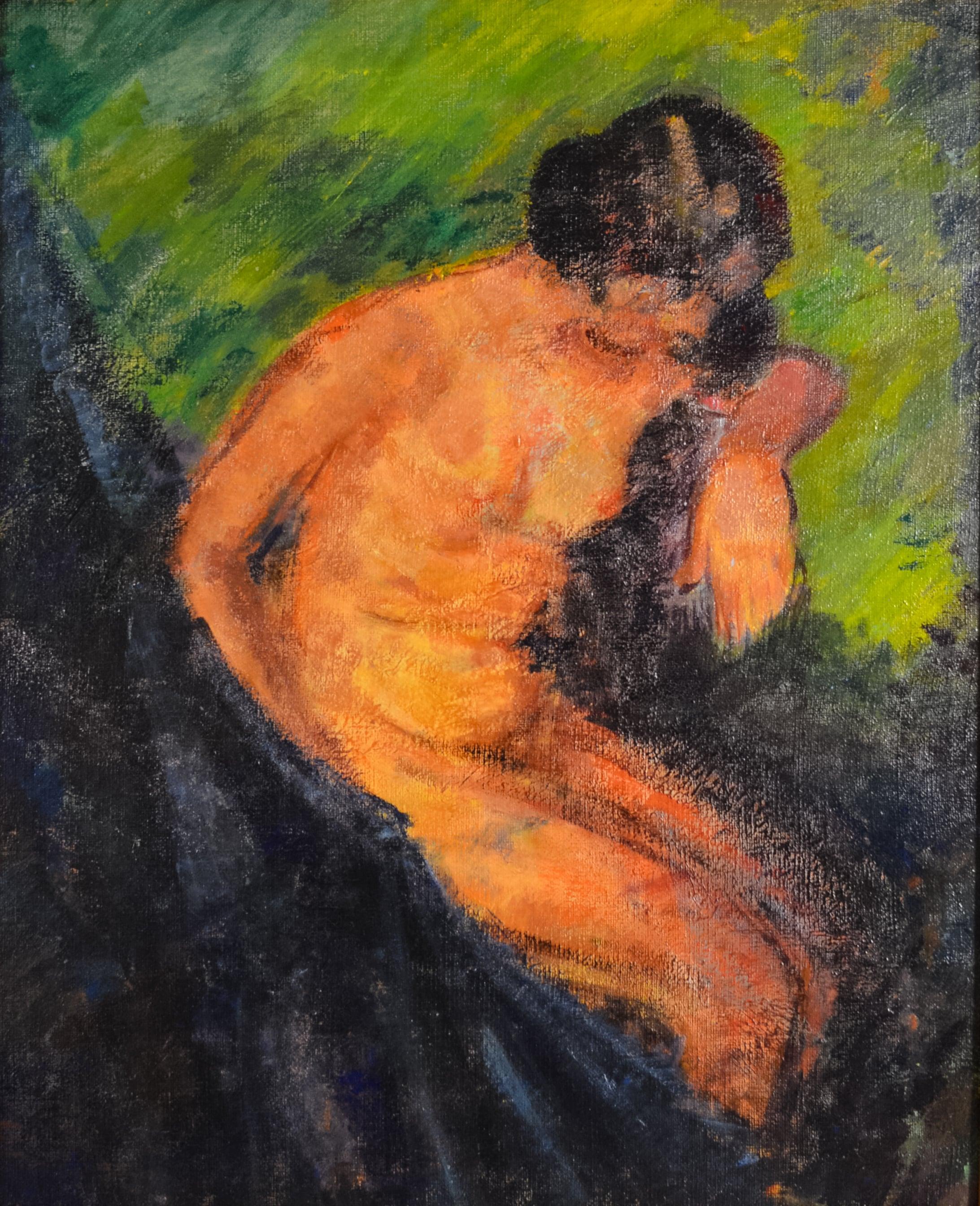Items Similar to "Woman on a Staircase, Sketch" Everett Shinn, Ashcan School, Theater Scene
Want more images or videos?
Request additional images or videos from the seller
1 of 10
Everett Shinn"Woman on a Staircase, Sketch" Everett Shinn, Ashcan School, Theater Scenecirca 1935
circa 1935
About the Item
Everett Shinn
Woman on a Staircase, Sketch, circa 1935
Signed on the reverse and on the stretcher
Oil on canvas
30 x 25 inches
Everett Shinn, a future member of the Eight and remarkable, rather theatrical personality was born at Woodstown, New Jersey in 1873. Even more recent sources give 1876 as the year of Everett Shinn's birth but the artist usually lied about his age to appear younger than he actually was. Edith DeShazo claimed that information from family members established the date of November 6, 1876 as Shinn's birthday. But if this is true, he would have enrolled at the Spring Garden Institute in Philadelphia to study industrial art at the age of twelve. Born to a Quaker named Isaiah Conklin Shinn and Josephine Ransley Shinn, Everett was their third child. He enjoyed a happy childhood as an undisciplined boy fond of sweets, acrobatics, and the circus.
Shinn opted for the Pennsylvania Academy of the Fine Arts for instruction in the fall of 1893, and began as a staff artist for the Philadelphia Press. At that time William Glackens was working there as well, while John Sloan was at the Inquirer. A year later, Glackens was at the Press, and also, in 1894, George Luks joined the staff there. As DeShazo explained, "the Press art department became a meeting place for men both on the staff and off with similar artistic and literary interests." Members of the same group also met at Robert Henri's studio. By 1897, Shinn was in New York, working for the New York World where Luks had been for about a year. The rest of the "Philadelphia Four" would follow them before long.
Shinn spent much of 1898 hounding the offices of Harper's until finally, the editor and publisher, Colonel George Harvey saw his portfolio, then commissioned a view of the Old Metropolitan Opera House in a snowstorm. The pastel appeared about a year later in the February 17th issue of Harper's Weekly, in 1900. Meanwhile, Shinn kept busy with decorative work (murals, screens, and door panels) at private residences and even in Trenton, New Jersey's City Hall. In 1899, the Boussod-Valadon Galleries gave Shinn his first one-man show. He continued to carry out commissions for illustrations. Shinn began exhibiting at the Pennsylvania Academy (1899-1908) and at the Art Institute of Chicago (1903-43).
A trip to Europe is documented in 1900 by an exhibition at Goupil's in Paris and by various drawings of Paris and London but nothing more appears to be known about where Shinn went or what he saw, except that he was in Paris in July. Undoubtedly, he would have seen the art at the Paris Universal Exposition. DeShazo noted that after having returned to America, Shinn lost interest in lower class urban life, and Young pointed out that unlike most members of the Eight, Shinn was not attracted to art focused on "people sleeping under bridges." In fact, he loved the glamor of Uptown, fashionably dressed ladies, and above all, Shinn wanted to depict the excitement of the theater. He himself was an amateur playwright. Shinn used spatial devices that Degas had initiated earlier but as Young rightly observed, Jean-Louis Forain (1852-1931) is a more accurate source for Shinn's chic theatrical pieces, dancers, and cabaret scenes. Théophile Steinlen (1859-1901) was another artist popular with the Philadelphia artist-reporters group, as Ferber noted.
Shinn was not part of the National Arts Club exhibition of works by future members of the Eight in 1904, but he was mentioned by Gallatin in 1906 as a kind of American Degas. The author praised Shinn's draftsmanship and the technique of his pastels: "Very real they are: we might almost imagine ourselves looking in upon the actual scene." Shinn did take part in Macbeth Galleries' famous show four years later. He exhibited eight works, including The Hippodrome, London (Art Institute of Chicago), The White Ballet, ca. 1905, and The Orchestra Pit (both: collection of Mr. and Mrs. Arthur G. Altschul). One of his works sold, a painting now called Revue (Whitney Museum of American Art), formerly titled Girl in Blue. Shinn also participated in the Exhibition of Independent Artists in 1910 and finished the murals in Trenton in the following year. Milton Brown regarded these depictions by Shinn of pottery kilns and steel mills as "important . . . in that they treated a contemporary industrial subject rather than an historical or allegorical scene."
Shinn was invited but refused to exhibit in the 1913 Armory Show. In fact, at that time, he was working on neo-Rococo decorative panels in private residences. Not much has been written on Shinn's activities between 1920 and 1940. He did not exhibit often but continued to work as an illustrator. In the 1940s, Shinn was represented by Ferargil Galleries. He contributed "Recollections of The Eight," an essay in the Brooklyn Museum's catalogue of the exhibition The Eight, which opened on 24 November 1943. The rather monochromatic Washington Square (Addison Gallery of American Art) is a late work, from around 1945. Shinn, who died in New York City on May 1, 1953, managed to outlive all other members of the Eight. Unfortunately for us all, a thorough, scholarly monograph on the artist remains to be written. Shinn showed the impressionists' love of contemporary subject matter and painted in a spontaneous, non-academic manner. In fact, critics seem to agree that Shinn's facility was his downfall. On the other hand, he maintained visual and narrative clarity, as his penchant toward illustration prevailed.
- Creator:Everett Shinn (1876-1953, American)
- Creation Year:circa 1935
- Dimensions:Height: 40 in (101.6 cm)Width: 35 in (88.9 cm)
- Medium:
- Movement & Style:
- Period:
- Condition:
- Gallery Location:New York, NY
- Reference Number:1stDibs: LU1841214091312
About the Seller
5.0
Platinum Seller
These expertly vetted sellers are 1stDibs' most experienced sellers and are rated highest by our customers.
Established in 2021
1stDibs seller since 2022
59 sales on 1stDibs
Typical response time: 1 hour
- ShippingRetrieving quote...Ships From: New York, NY
- Return PolicyA return for this item may be initiated within 3 days of delivery.
More From This SellerView All
- "Julie Hyneman at Central Park, New York City, " Herman Hyneman, Gilded AgeBy Herman HynemanLocated in New York, NYHerman N. Hyneman (1849 - 1907) Julie Hyneman at Central Park Oil on canvas 25 x 20 inches Signed lower left Herman N. Hyneman was a noted American portrait and figure painter with ties to both Philadelphia and New York. He was born July 27,1849 to Leon and Adeline Hyneman in Philadelphia. ("Who Was Who in American Art" lists his birth date as either 1849 or 1859, but we have confirmed that the birth date is 1849). Virtually nothing is known about his early years, but given the fact that the family resided in a wealthy section of Philadelphia and the fact that he traveled to Paris to study in the studio of Leon Bonnat when he was but 20 years old, it is presumed that the family was financially comfortable if not well to do. Hyneman exhibited at the Paris Salon in 1879 and 1881, which was quite an accomplishment given his tender age. He returned to the United States in 1882 and after a year in Philadelphia, he established a studio at 58 West 57th Street, New York, NY, where he painted portraits to support himself and scenes of beautiful fair-skinned women walking in the snow to exhibit at major exhibitions throughout the United States. Hyneman exhibited at the the Brooklyn Art Association in 1882, 1883 and 1884 and at the Pennsylvania Academy of Fine Arts in 1883 and 1888. Beginning in 1882 and continuing up until 1905, he exhibited regularly at the National Academy of Design. Despite the fact that he exhibited fourteen paintings at the National Academy over a span of three different decades, he was never elected as a member. In the 1880's his paintings sold for between $100 and $1500, which were substantial sums for that period. Hyneman also exhibited at the Salmagundi Club and the Philadelphia Art Club and was a member of each organization. He won a medal at the American Art Society in 1904 and also exhibited at the Chicago Art Institute. A handwritten label on one of his paintings indicates that he also exhibited in Budapest, Hungary. In 1892, Hyneman married the noted artist Juliet Jolley (aka Jolly), who had previously modeled for him. Thereafter, they shared a studio and on at least one occasion exhibited together. The February 5, 1896 edition of the "New York Times" reported on a "pleasant studio reception" at 58 West 57th Street where the paintings of both Herman and Juliet were shown to members of New York Society including Mr. And Mrs. Edwin Blashfield. At least one of Hyneman's Painting " A Sensation on Wall Street" which depicted a lovely young woman in fur coat with Muff in front of the Stock Exchange, was made into a post card and reproductions of his paintings are known to exist, although not plentiful. At least one etching is known, "Desdemona," which was reproduced in a book by Frederic Stokes. Herman Hyneman...Category
Late 19th Century Ashcan School Figurative Paintings
MaterialsCanvas, Oil
- "Female Nude, " Edith Glackens Dimock, Ashcan School Figurative PaintingBy Edith Glackens DimockLocated in New York, NYEdith (Glackens) Dimock (1876 - 1955) Untitled (Female Nude), circa 1915 Oil on canvas 34 1/2 x 28 1/4 inches Signed lower left Provenance: Private Colle...Category
1910s Ashcan School Nude Paintings
MaterialsCanvas, Oil
- "Flower Girl, " John George Brown, Genre Painting, Street FigureBy John George BrownLocated in New York, NYJohn George Brown (1831 - 1913) Flower Girl, circa 1900 Watercolor on paper 6 3/4 x 4 3/4 inches Signed lower left Period Hand Carved Foster Brothers Fram...Category
Early 1900s Ashcan School Figurative Paintings
MaterialsPaper, Watercolor
- "Beach at Atlantic City, New Jersey" Amy Londoner, Ashcan School, FigurativeBy Amy LondonerLocated in New York, NYAmy Londoner Beach at Atlantic City, circa 1922 Signed lower right Pastel on paper Sight 23 x 18 inches Amy Londoner (April 12, 1875 – 1951) was an American painter who exhibited at...Category
1920s Ashcan School Figurative Paintings
MaterialsPastel, Paper
- "Night Stroll" Amy Londoner, Ashcan School, Figurative NocturneBy Amy LondonerLocated in New York, NYAmy Londoner Beach at Atlantic City, circa 1922 Signed lower right Pastel on paper Sight 23 x 18 inches Amy Londoner (April 12, 1875 – 1951) was an American painter who exhibited at...Category
1910s Ashcan School Figurative Paintings
MaterialsPastel, Paper
- "Musical Conductor" Amy Londoner, Ashcan School, Figurative Concert SceneBy Amy LondonerLocated in New York, NYAmy Londoner Musical Conductor, 1922 Signed and dated lower right Pastel on paper Sight 18 x 23 inches Amy Londoner (April 12, 1875 – 1951) was an American painter who exhibited at ...Category
1920s Ashcan School Figurative Paintings
MaterialsPastel, Paper
You May Also Like
- "Jazz Club"By Jane GibbsLocated in Lambertville, NJSigned Lower LeftCategory
20th Century Ashcan School Figurative Paintings
MaterialsCanvas, Oil
- 'The Artist as a Young Man' by Hal Frater - Ashcan School Figurative PaintingBy Hal FraterLocated in Carmel, CAHal Frater's "The Artist as a Young Man" is a striking oil on canvas that captures the essence of the artist himself, rendered in a raw, emotive style. The palette is earthy, with na...Category
1950s Ashcan School Figurative Paintings
MaterialsCanvas, Oil
- 1940s New York Interior -- An Evening Scene of Artist and His WifeLocated in Soquel, CA1940s New York Interior -- An Evening Scene of Artist and His Wife Wonderful moody 1940s New York interior and figurative oil painting in Ashcan Schoo...Category
1940s Ashcan School Interior Paintings
MaterialsOil, Canvas, Cardboard
- Children Playing on The Slide, Ashcan School - Lower East SideBy Jerome MyersLocated in Miami, FLImmigrant children from New York's Lower East Side are joyfully captured whizzing down on a slide. From the window of a tenement building, a lone adult with child witnesses the foli...Category
Early 1900s Ashcan School Figurative Paintings
MaterialsCanvas, Oil
- Clown with Big PantsBy Everett ShinnLocated in New York, NYClown With Big Pants, 1942, by Everett Shinn (1876-1953) Oil on canvas 12 x 10 inches unframed (30.48 x 25.4 cm) 19 ½ x 17 ¼ inches framed (49.53 x 43.815 cm) Signed and dated on bot...Category
20th Century Ashcan School Figurative Paintings
MaterialsOil
- Woman in RedBy Alexander Oscar LevyLocated in Buffalo, NYAlexander O. Levy was a painter, illustrator, printmaker and designer who was born in 1881 in Bonn, Germany. He died in 1946 in Buffalo, New York. At age three, he was brought to ...Category
1920s Ashcan School Figurative Paintings
MaterialsOil, Wood Panel




